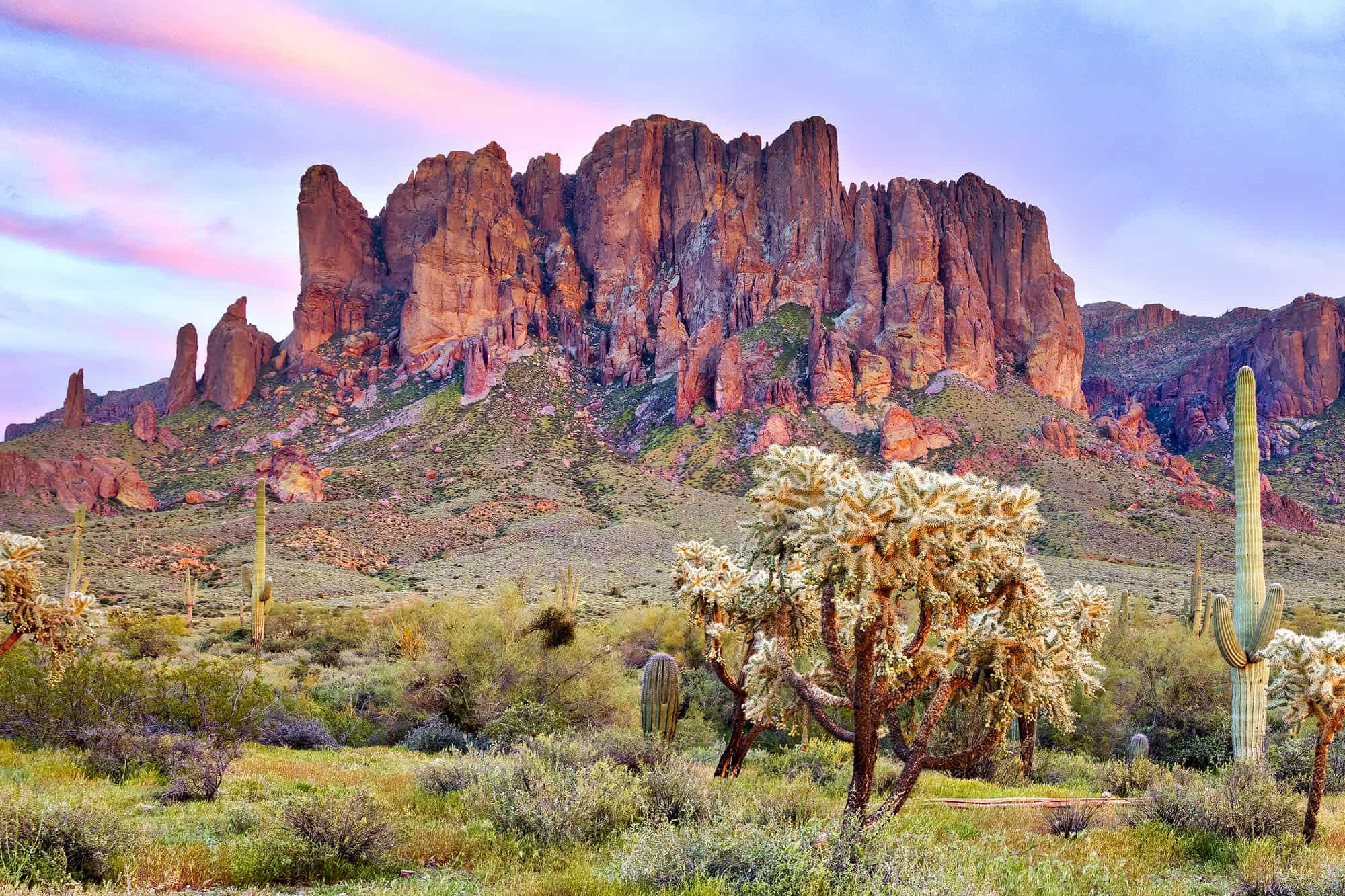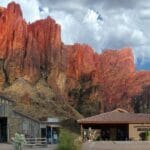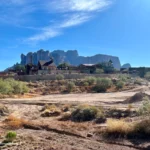Hey, folks! Get ready to dive into the wild world of Arizona’s Superstition Mountains. These mysterious peaks are like something out of a legend, with stories swirling around them like dust in the wind. And guess what? We’re going to uncover the secret behind their curious name: Superstition Mountain. So, buckle up and let’s unravel the enigma together!
Why Is It Called Superstition Mountain?
Some places just seem to radiate an aura of mystery, and Superstition Mountain is undoubtedly one of them. But why on earth would anyone call a mountain “Superstition”? The answer lies in a fascinating clash of cultures and beliefs dating back to the late 1860s.
Imagine a time when farmers, probably more concerned with crops than creepy stories, encountered the Pima Indians who called this land home. The Pima, deeply connected to the natural world, viewed the mountains with a reverence bordering on trepidation. They spoke of inexplicable sounds echoing through the canyons, whispers carried on the wind, and a pervasive feeling of unease.
To the pragmatic farmers, these tales seemed like, well, superstitions. And so the name stuck, a testament to the cultural gap between them and the Pima’s deep-rooted beliefs.
Adding another layer to the mystique, Apache folklore links Superstition Mountain to the entrance of the underworld. While the interpretation of this legend remains open to debate, it hints at the enduring power of the mountains to blur the lines between the known and the unknown.
What is the Story Behind the Superstition Mountain?
Long before adventurers dared to explore its slopes, Superstition Mountain was known as “Spirit Mountain” by the Pima Indians. They believed it was a sacred place where powerful spirits roamed freely and recounted tales of strange occurrences that defied explanation.
When settlers and farmers arrived in the Salt River Valley, they, too, began noticing peculiar events around the mountain. Perhaps influenced by the Pima tales, they started calling it “Superstition Mountain,” a name that perfectly encapsulated the sense of mystery and unease that clung to the peaks.
The stories surrounding Superstition Mountain grew with each passing year, encompassing tales of lost treasures, mysterious disappearances, and whispers of a curse. This blend of history, folklore, and the unknown continues to draw people to the mountain, seeking to uncover its secrets or simply experience its unique energy.
What Is the Mystery of the Superstition Mountains?
The Superstition Mountains’ mystique stems from a fascinating interplay of Native American beliefs, settler experiences, and the enduring power of the unknown.
The Pima Indians, with their intimate knowledge of the land, perceived the mountains as a place of powerful spiritual energy. They shared tales of peculiar sounds, vanishing individuals, and an overall sense that some things were best left undisturbed.
As settlers arrived and heard these tales, they, too, began to attribute strange happenings to the mountains. The name “Superstition Mountains” arose from this blend of indigenous beliefs and settler interpretations, forever linking the peaks to a sense of mystery and the supernatural.
Adding to the allure, tales of lost treasures, hidden mines, and vanished souls have circulated for centuries. While some dismiss these stories as mere folklore, others believe they hint at the mountains’ true nature. Whether rooted in reality or simply products of human imagination, these tales continue to attract those seeking adventure and a glimpse into the unknown.
How Many People Have Died on Superstition Mountain?
While shrouded in mystery and legend, Superstition Mountain also presents very real dangers. The unforgiving landscape has claimed many lives over the years, with estimates suggesting well over 100 fatalities throughout its history.
The treacherous terrain, including steep canyons, rocky cliffs, and unpredictable weather, can quickly turn a pleasant hike into a life-threatening situation. Water scarcity adds another layer of risk, with dehydration a constant threat in the arid climate.
Despite these dangers, Superstition Mountain continues to beckon adventurers and explorers. Some are lured by tales of lost gold, while others crave the thrill of conquering a challenging and untamed wilderness. Regardless of their motivations, all who venture into the Superstitions must do so with respect and awareness of the risks involved.
It’s worth noting that research on this topic is ongoing. Historians and researchers are continually uncovering new information, attempting to piece together the stories of those who vanished into the Superstitions and understand the circumstances surrounding their fates.
What Is the Curse of Superstition Mountain?
The Superstition Mountain’s curse isn’t a single, definable entity but rather a collection of stories and whispers woven into the very fabric of the mountain. It’s the Pima Indians’ ancient tales of strange sounds and vanishing people, passed down through generations, that first hinted at something amiss.
As settlers arrived and heard these tales, they, too, began to view the mountain with a sense of foreboding. The name “Superstition Mountain” arose from this shared unease, a reflection of the belief that the mountain held a power beyond human comprehension.
Some whisper of the mountain being haunted, perhaps by the spirits of those who met untimely ends within its rocky embrace. Others believe ancient, malevolent entities guard the mountains’ treasures, punishing those who dare to seek them.
While the true nature of the curse remains elusive, its impact on the mountain’s reputation is undeniable. The Superstition Mountain stands as a stark reminder that some places retain an aura of mystery, a power that tugs at the fringes of our understanding and leaves us questioning what might lie hidden just beyond our sight.
Why Do They Call Them the Superstition Mountains?
The Superstition Mountains earned their evocative name through a blend of Native American beliefs and early settler experiences.
Long before European arrival, the Akimel O’odham people considered these mountains spiritually potent and potentially dangerous. They shared tales of strange happenings, unexplained disappearances, and an overarching sense that the mountains commanded respect and even a degree of fear.
When settlers arrived in the 1800s, they likely absorbed these stories and began to view the mountains through a similar lens. The name “Superstition Mountains” likely arose organically from this blend of indigenous beliefs and settler interpretations, becoming a testament to the enduring power of stories to shape our perceptions of places.
Adding to their mystique, the Superstition Mountains have a history rooted in exploration and the pursuit of hidden treasures. While the mountains offer breathtaking beauty and recreational opportunities, they also hold the potential for danger, with treacherous terrain and unpredictable weather adding an element of risk to any venture into their depths.
Do People Go Missing in the Superstition Mountains?
The Superstition Mountains have a reputation for mystery that goes beyond mere stories. While the exact number remains unknown, local tales and historical whispers suggest that numerous individuals have vanished within their rugged terrain.
Some attribute these disappearances to the mountain itself, with its harsh weather conditions, confusing trails, and limited water sources. Getting lost or succumbing to the elements are very real dangers that hikers face.
However, some believe a darker force may be at play. They point to the mountains’ long-standing association with curses and supernatural phenomena, suggesting that something sinister might lurk within.
While the truth likely lies somewhere between natural hazards and the allure of folklore, the Superstition Mountains retain an air of mystery surrounding those who have vanished. It serves as a reminder that even in our modern age, some places hold onto their secrets, leaving us to ponder the fates of those who ventured into the unknown and never returned.
What Is the Story of Cursed Mountain?
The Superstition Mountains’ reputation for being cursed stems from the deeply held beliefs of the Pima Indians, who considered the mountains sacred and potentially dangerous. They told tales of unsettling sounds, vanishing individuals, and a pervasive sense of unease that permeated the area.
When farmers settled in the Salt River Valley, they likely heard these stories and incorporated them into their own understanding of the landscape. The name “Superstition Mountains” likely emerged from this blend of indigenous beliefs and settler interpretations, reflecting the perception of a supernatural force at play.
Adding to the intrigue, stories of lost gold mines, hidden treasures, and strange lights in the night sky have circulated for generations, further fueling the belief that the Superstition Mountains hold secrets beyond our comprehension.
To this day, these mountains attract adventurers, treasure hunters, and those seeking a glimpse into the unknown. Whether drawn by the allure of riches or the thrill of exploring a place steeped in legend, those who venture into the Superstitions do so with the understanding that they are entering a realm where the line between reality and folklore blurs.
What Is the Story Behind Devil’s Peak?
While we’ve been focusing on the Superstition Mountains in Arizona, it’s worth noting that other mountains share similarly evocative names rooted in folklore and legend. One such example is Devil’s Peak in Cape Town, South Africa.
Before earning its current name, Devil’s Peak was known as “Windberg,” meaning “Windy Mountain” in Dutch. The name shifted sometime in the 1800s, likely due to a popular legend involving a Dutchman named Jan van Hunks.
As the story goes, van Hunks enjoyed smoking his pipe on the mountain slopes. One day, he encountered the Devil himself and, being a cunning fellow, challenged him to a smoking contest. The ensuing cloud of smoke engulfed the mountain, eventually leading to van Hunks outsmarting the Devil.
This tale cemented the mountain’s new name, “Duivels Kop” in Dutch, which translates to “Devil’s Head” in English. The legend serves as a reminder that even seemingly straightforward names can have fascinating and unexpected origins rooted in folklore and the human imagination.
What Is the Story Behind the Lost Dutchman Mine?
The legend of the Lost Dutchman mine revolves around a German immigrant named Jacob Waltz (often referred to as “the Dutchman”) who arrived in Arizona in the late 1800s, claiming to have discovered a gold mine of unimaginable wealth.
Waltz remained tight-lipped about the mine’s location, offering only cryptic clues and riddles that have tantalized treasure hunters for over a century. He died in 1891 without ever revealing the exact whereabouts of his supposed discovery.
Since then, countless adventurers and fortune seekers have ventured into the Superstition Mountains, hoping to decipher Waltz’s clues and unearth the legendary Lost Dutchman mine. The mountains’ rugged terrain, challenging climate, and air of mystery only add to the allure.
While some believe the mine is nothing more than a folktale, others cling to the possibility that it exists, hidden in plain sight, waiting for a lucky (or perhaps skilled) individual to uncover its secrets.
The Lost Dutchman mine exemplifies the enduring power of legends and the human desire to chase dreams of fortune and adventure. It serves as a reminder that some mysteries continue to captivate us, even as time passes and the line between fact and fiction blurs.
What Is the Story of Treasure Mountain?
While the Superstition Mountains might be the most famous mountains associated with lost treasures and mysterious tales, they’re not unique. Across the globe, mountains often capture the human imagination, becoming imbued with legends of hidden riches and supernatural forces.
These “Treasure Mountains” often find their roots in a blend of indigenous folklore, settler experiences, and the very real dangers and challenges posed by mountainous terrain. Stories of lost mines, vanished explorers, and curses guarding untold wealth intertwine with the physical landscape, creating a tapestry of mystery and intrigue.
The enduring power of these stories likely stems from the universal human desire for adventure, wealth, and the thrill of the unknown. Mountains, with their imposing presence, hidden passages, and unpredictable nature, serve as the perfect backdrop for such tales.
While the existence of many “Treasure Mountains” and their hidden riches remains unproven, their allure lies in the possibility, the enduring hope that somewhere within their rocky embrace, fortune and adventure await those brave or perhaps foolish enough to seek them.
Important Note:
For a deeper dive into the captivating world of the Superstition Mountains, I encourage you to explore these resources:
- Explore the enigmatic superstition mountains, a rugged wilderness where ancient legends entwine with breathtaking landscapes. Their towering peaks, cloaked in mystery, invite you to uncover the secrets that lie within their embrace.
- Delve into the fascinating world of the superstition mountains and satisfy your curiosity about their towering heights. By accessing how tall is superstition mountain, you’ll embark on a virtual journey that unravels the exact dimensions of these majestic peaks, leaving you awe-inspired by their colossal stature.
- Guatemala vs. Costa Rica: Plan Your Trip Smartly - April 16, 2025
- Master Types of Pumps: Ultimate Guide to Selection - April 16, 2025
- Unlock Types of Makeup Secrets: Master Any Look Now - April 16, 2025
















